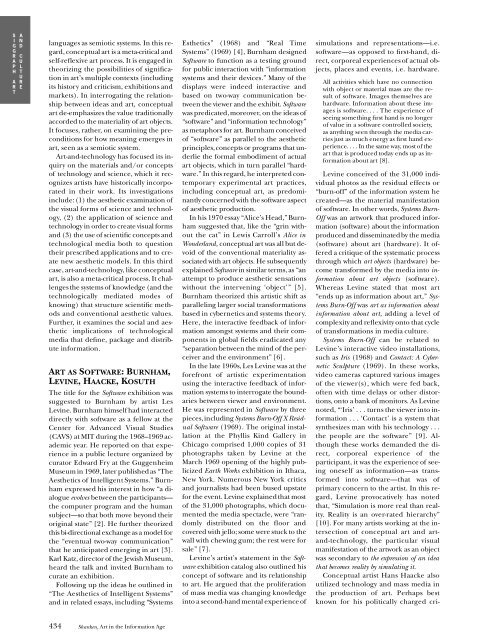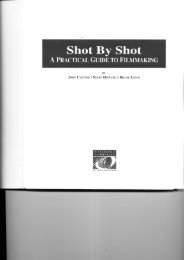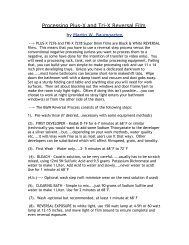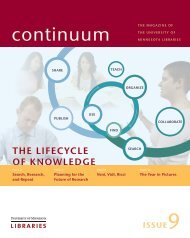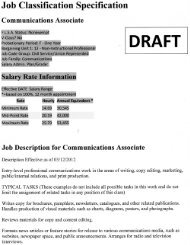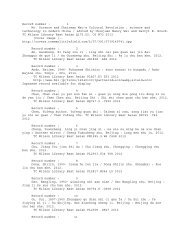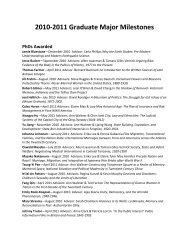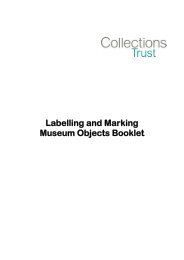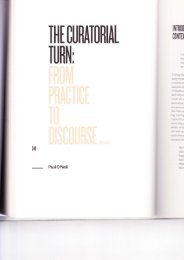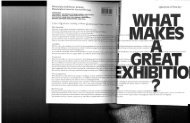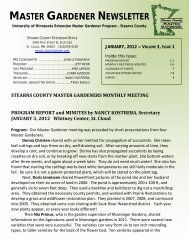Art in the Information Age: Technology and Conceptual Art
Art in the Information Age: Technology and Conceptual Art
Art in the Information Age: Technology and Conceptual Art
You also want an ePaper? Increase the reach of your titles
YUMPU automatically turns print PDFs into web optimized ePapers that Google loves.
S<br />
I<br />
G<br />
G<br />
R<br />
A<br />
P<br />
H<br />
A<br />
R<br />
T<br />
A<br />
N<br />
D<br />
C<br />
U<br />
L<br />
T<br />
U<br />
R<br />
E<br />
languages as semiotic systems. In this regard,<br />
conceptual art is a meta-critical <strong>and</strong><br />
self-reexive art process. It is engaged <strong>in</strong><br />
<strong>the</strong>oriz<strong>in</strong>g <strong>the</strong> possibilities of signication<br />
<strong>in</strong> art’s multiple contexts (<strong>in</strong>clud<strong>in</strong>g<br />
its history <strong>and</strong> criticism, exhibitions <strong>and</strong><br />
markets). In <strong>in</strong>terrogat<strong>in</strong>g <strong>the</strong> relationship<br />
between ideas <strong>and</strong> art, conceptual<br />
art de-emphasizes <strong>the</strong> value traditionally<br />
accorded to <strong>the</strong> materiality of art objects.<br />
It focuses, ra<strong>the</strong>r, on exam<strong>in</strong><strong>in</strong>g <strong>the</strong> preconditions<br />
for how mean<strong>in</strong>g emerges <strong>in</strong><br />
art, seen as a semiotic system.<br />
<strong>Art</strong>-<strong>and</strong>-technology has focused its <strong>in</strong>quiry<br />
on <strong>the</strong> materials <strong>and</strong>/or concepts<br />
of technology <strong>and</strong> science, which it recognizes<br />
artists have historically <strong>in</strong>corporated<br />
<strong>in</strong> <strong>the</strong>ir work. Its <strong>in</strong>vestigations<br />
<strong>in</strong>clude: (1) <strong>the</strong> aes<strong>the</strong>tic exam<strong>in</strong>ation of<br />
<strong>the</strong> visual forms of science <strong>and</strong> technology,<br />
(2) <strong>the</strong> application of science <strong>and</strong><br />
technology <strong>in</strong> order to create visual forms<br />
<strong>and</strong> (3) <strong>the</strong> use of scientic concepts <strong>and</strong><br />
technological media both to question<br />
<strong>the</strong>ir prescribed applications <strong>and</strong> to create<br />
new aes<strong>the</strong>tic models. In this third<br />
case, art-<strong>and</strong>-technology, like conceptual<br />
art, is also a meta-critical process. It challenges<br />
<strong>the</strong> systems of knowledge (<strong>and</strong> <strong>the</strong><br />
technologically mediated modes of<br />
know<strong>in</strong>g) that structure scientic methods<br />
<strong>and</strong> conventional aes<strong>the</strong>tic values.<br />
Fur<strong>the</strong>r, it exam<strong>in</strong>es <strong>the</strong> social <strong>and</strong> aes<strong>the</strong>tic<br />
implications of technological<br />
media that dene, package <strong>and</strong> distribute<br />
<strong>in</strong>formation.<br />
ART AS SOFTWARE: BURNHAM,<br />
LEVINE, HAACKE, KOSUTH<br />
The title for <strong>the</strong> Software exhibition was<br />
suggested to Burnham by artist Les<br />
Lev<strong>in</strong>e. Burnham himself had <strong>in</strong>teracted<br />
directly with software as a fellow at <strong>the</strong><br />
Center for Advanced Visual Studies<br />
(CAVS) at MIT dur<strong>in</strong>g <strong>the</strong> 1968–1969 academic<br />
year. He reported on that experience<br />
<strong>in</strong> a public lecture organized by<br />
curator Edward Fry at <strong>the</strong> Guggenheim<br />
Museum <strong>in</strong> 1969, later published as “The<br />
Aes<strong>the</strong>tics of Intelligent Systems.” Burnham<br />
expressed his <strong>in</strong>terest <strong>in</strong> how “a dialogue<br />
evolves between <strong>the</strong> participants—<br />
<strong>the</strong> computer program <strong>and</strong> <strong>the</strong> human<br />
subject—so that both move beyond <strong>the</strong>ir<br />
orig<strong>in</strong>al state” [2]. He fur<strong>the</strong>r <strong>the</strong>orized<br />
this bi-directional exchange as a model for<br />
<strong>the</strong> “eventual two-way communication”<br />
that he anticipated emerg<strong>in</strong>g <strong>in</strong> art [3].<br />
Karl Katz, director of <strong>the</strong> Jewish Museum,<br />
heard <strong>the</strong> talk <strong>and</strong> <strong>in</strong>vited Burnham to<br />
curate an exhibition.<br />
Follow<strong>in</strong>g up <strong>the</strong> ideas he outl<strong>in</strong>ed <strong>in</strong><br />
“The Aes<strong>the</strong>tics of Intelligent Systems”<br />
<strong>and</strong> <strong>in</strong> related essays, <strong>in</strong>clud<strong>in</strong>g “Systems<br />
434 Shanken, <strong>Art</strong> <strong>in</strong> <strong>the</strong> <strong>Information</strong> <strong>Age</strong><br />
Es<strong>the</strong>tics” (1968) <strong>and</strong> “Real Time<br />
Systems” (1969) [4], Burnham designed<br />
Software to function as a test<strong>in</strong>g ground<br />
for public <strong>in</strong>teraction with “<strong>in</strong>formation<br />
systems <strong>and</strong> <strong>the</strong>ir devices.” Many of <strong>the</strong><br />
displays were <strong>in</strong>deed <strong>in</strong>teractive <strong>and</strong><br />
based on two-way communication between<br />
<strong>the</strong> viewer <strong>and</strong> <strong>the</strong> exhibit. Software<br />
was predicated, moreover, on <strong>the</strong> ideas of<br />
“software” <strong>and</strong> “<strong>in</strong>formation technology”<br />
as metaphors for art. Burnham conceived<br />
of “software” as parallel to <strong>the</strong> aes<strong>the</strong>tic<br />
pr<strong>in</strong>ciples, concepts or programs that underlie<br />
<strong>the</strong> formal embodiment of actual<br />
art objects, which <strong>in</strong> turn parallel “hardware.”<br />
In this regard, he <strong>in</strong>terpreted contemporary<br />
experimental art practices,<br />
<strong>in</strong>clud<strong>in</strong>g conceptual art, as predom<strong>in</strong>antly<br />
concerned with <strong>the</strong> software aspect<br />
of aes<strong>the</strong>tic production.<br />
In his 1970 essay “Alice’s Head,” Burnham<br />
suggested that, like <strong>the</strong> “gr<strong>in</strong> without<br />
<strong>the</strong> cat” <strong>in</strong> Lewis Carroll’s Alice <strong>in</strong><br />
Wonderl<strong>and</strong>, conceptual art was all but devoid<br />
of <strong>the</strong> conventional materiality associated<br />
with art objects. He subsequently<br />
expla<strong>in</strong>ed Software <strong>in</strong> similar terms, as “an<br />
attempt to produce aes<strong>the</strong>tic sensations<br />
without <strong>the</strong> <strong>in</strong>terven<strong>in</strong>g ‘object’” [5].<br />
Burnham <strong>the</strong>orized this artistic shift as<br />
parallel<strong>in</strong>g larger social transformations<br />
based <strong>in</strong> cybernetics <strong>and</strong> systems <strong>the</strong>ory.<br />
Here, <strong>the</strong> <strong>in</strong>teractive feedback of <strong>in</strong>formation<br />
amongst systems <strong>and</strong> <strong>the</strong>ir components<br />
<strong>in</strong> global elds eradicated any<br />
“separation between <strong>the</strong> m<strong>in</strong>d of <strong>the</strong> perceiver<br />
<strong>and</strong> <strong>the</strong> environment” [6].<br />
In <strong>the</strong> late 1960s, Les Lev<strong>in</strong>e was at <strong>the</strong><br />
forefront of artistic experimentation<br />
us<strong>in</strong>g <strong>the</strong> <strong>in</strong>teractive feedback of <strong>in</strong>formation<br />
systems to <strong>in</strong>terrogate <strong>the</strong> boundaries<br />
between viewer <strong>and</strong> environment.<br />
He was represented <strong>in</strong> Software by three<br />
pieces, <strong>in</strong>clud<strong>in</strong>g Systems Burn-Off X Residual<br />
Software (1969). The orig<strong>in</strong>al <strong>in</strong>stallation<br />
at <strong>the</strong> Phyllis K<strong>in</strong>d Gallery <strong>in</strong><br />
Chicago comprised 1,000 copies of 31<br />
photographs taken by Lev<strong>in</strong>e at <strong>the</strong><br />
March 1969 open<strong>in</strong>g of <strong>the</strong> highly publicized<br />
Earth Works exhibition <strong>in</strong> Ithaca,<br />
New York. Numerous New York critics<br />
<strong>and</strong> journalists had been bused upstate<br />
for <strong>the</strong> event. Lev<strong>in</strong>e expla<strong>in</strong>ed that most<br />
of <strong>the</strong> 31,000 photographs, which documented<br />
<strong>the</strong> media spectacle, were “r<strong>and</strong>omly<br />
distributed on <strong>the</strong> oor <strong>and</strong><br />
covered with jello; some were stuck to <strong>the</strong><br />
wall with chew<strong>in</strong>g gum; <strong>the</strong> rest were for<br />
sale” [7].<br />
Lev<strong>in</strong>e’s artist’s statement <strong>in</strong> <strong>the</strong> Software<br />
exhibition catalog also outl<strong>in</strong>ed his<br />
concept of software <strong>and</strong> its relationship<br />
to art. He argued that <strong>the</strong> proliferation<br />
of mass media was chang<strong>in</strong>g knowledge<br />
<strong>in</strong>to a second-h<strong>and</strong> mental experience of<br />
simulations <strong>and</strong> representations—i.e.<br />
software—as opposed to rst-h<strong>and</strong>, direct,<br />
corporeal experiences of actual objects,<br />
places <strong>and</strong> events, i.e. hardware.<br />
All activities which have no connection<br />
with object or material mass are <strong>the</strong> result<br />
of software. Images <strong>the</strong>mselves are<br />
hardware. <strong>Information</strong> about <strong>the</strong>se images<br />
is software. . . . The experience of<br />
see<strong>in</strong>g someth<strong>in</strong>g rst h<strong>and</strong> is no longer<br />
of value <strong>in</strong> a software controlled society,<br />
as anyth<strong>in</strong>g seen through <strong>the</strong> media carries<br />
just as much energy as rst h<strong>and</strong> experience.<br />
. . . In <strong>the</strong> same way, most of <strong>the</strong><br />
art that is produced today ends up as <strong>in</strong>formation<br />
about art [8].<br />
Lev<strong>in</strong>e conceived of <strong>the</strong> 31,000 <strong>in</strong>dividual<br />
photos as <strong>the</strong> residual effects or<br />
“burn-off” of <strong>the</strong> <strong>in</strong>formation system he<br />
created—as <strong>the</strong> material manifestation<br />
of software. In o<strong>the</strong>r words, Systems Burn-<br />
Off was an artwork that produced <strong>in</strong>formation<br />
(software) about <strong>the</strong> <strong>in</strong>formation<br />
produced <strong>and</strong> dissem<strong>in</strong>ated by <strong>the</strong> media<br />
(software) about art (hardware). It offered<br />
a critique of <strong>the</strong> systematic process<br />
through which art objects (hardware) become<br />
transformed by <strong>the</strong> media <strong>in</strong>to <strong>in</strong>formation<br />
about art objects (software).<br />
Whereas Lev<strong>in</strong>e stated that most art<br />
“ends up as <strong>in</strong>formation about art,” Systems<br />
Burn-Off was art as <strong>in</strong>formation about<br />
<strong>in</strong>formation about art, add<strong>in</strong>g a level of<br />
complexity <strong>and</strong> reexivity onto that cycle<br />
of transformations <strong>in</strong> media culture.<br />
Systems Burn-Off can be related to<br />
Lev<strong>in</strong>e’s <strong>in</strong>teractive video <strong>in</strong>stallations,<br />
such as Iris (1968) <strong>and</strong> Contact: A Cybernetic<br />
Sculpture (1969). In <strong>the</strong>se works,<br />
video cameras captured various images<br />
of <strong>the</strong> viewer(s), which were fed back,<br />
often with time delays or o<strong>the</strong>r distortions,<br />
onto a bank of monitors. As Lev<strong>in</strong>e<br />
noted, “‘Iris’ . . . turns <strong>the</strong> viewer <strong>in</strong>to <strong>in</strong>formation<br />
. . . ‘Contact’ is a system that<br />
syn<strong>the</strong>sizes man with his technology . . .<br />
<strong>the</strong> people are <strong>the</strong> software” [9]. Although<br />
<strong>the</strong>se works dem<strong>and</strong>ed <strong>the</strong> direct,<br />
corporeal experience of <strong>the</strong><br />
participant, it was <strong>the</strong> experience of see<strong>in</strong>g<br />
oneself as <strong>in</strong>formation—as transformed<br />
<strong>in</strong>to software—that was of<br />
primary concern to <strong>the</strong> artist. In this regard,<br />
Lev<strong>in</strong>e provocatively has noted<br />
that, “Simulation is more real than reality.<br />
Reality is an over-rated hierarchy”<br />
[10]. For many artists work<strong>in</strong>g at <strong>the</strong> <strong>in</strong>tersection<br />
of conceptual art <strong>and</strong> art<strong>and</strong>-technology,<br />
<strong>the</strong> particular visual<br />
manifestation of <strong>the</strong> artwork as an object<br />
was secondary to <strong>the</strong> expression of an idea<br />
that becomes reality by simulat<strong>in</strong>g it.<br />
<strong>Conceptual</strong> artist Hans Haacke also<br />
utilized technology <strong>and</strong> mass media <strong>in</strong><br />
<strong>the</strong> production of art. Perhaps best<br />
known for his politically charged cri-


